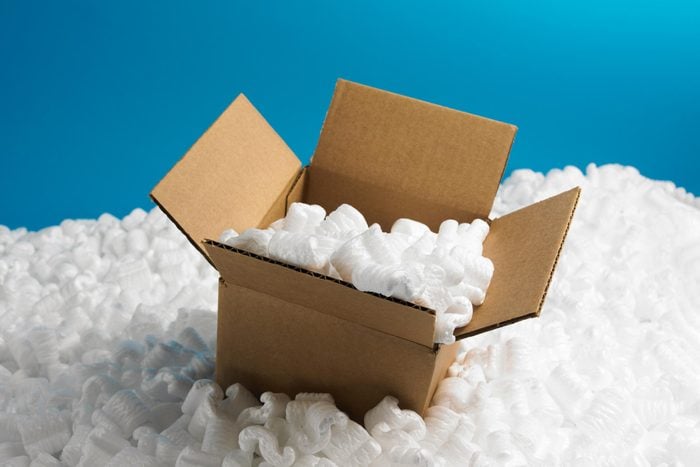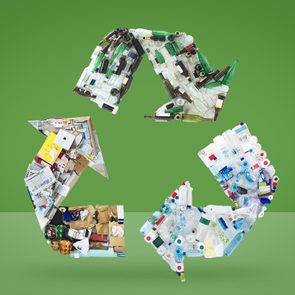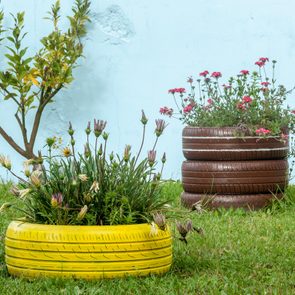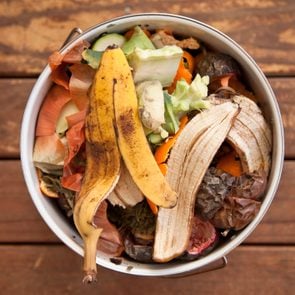How to Recycle Packing Material, and Why You’ll Want to Use Sustainable Shipping
Updated: Oct. 04, 2022

Before you add another item to your online cart or toss out those packing materials, check out our tips for more sustainable shipping and packaging.
The benefits of online shopping are clear: Skipping the trip to the store saves time, doesn’t require a car, and affords access to a wider variety of products, often at better prices. And when you’re the shipper, there’s a distinct joy in shipping out your own surprises to friends and family, or the satisfaction of selling something online and sending it off to a new home. But all those packages we send and receive also use up resources and create a great deal of waste.
The good news is, there are steps you can take to reduce your packaging waste and recycle and upcycle packing materials. And you’ll be in good company; many people are prioritizing sustainable shipping and packaging, and the future of recycling is looking brighter, with eco-friendly brands and sustainable fashion brands working to eliminate plastics, find creative ways to reduce packaging waste, recycle the right way, and share sustainable living advice with their customers. Here are some tips for more sustainable shipping and packaging.
What is sustainable packaging?
“The most sustainable packaging is no packaging,” says Friday Apaliski, aka the Sustainability Concierge. But, of course, a package will never make it past the post office if it’s not wrapped up properly. So when you are preparing items to ship, choose your packaging materials carefully. Before you head to the store to purchase supplies, start with what you’ve got at home. “Reuse the shipping materials you already have,” Apaliski says, such as old boxes. “Use newspaper as filler rather than styrofoam packing peanuts.”
Clara Albornoz, co-founder and co-CEO of List Perfectly, an e-commerce platform that allows resellers to cross-post to multiple marketplaces simultaneously, says that eco-friendly packaging options may include air pillows made from recycled materials, biodegradable packaging peanuts such as those made from mushrooms, and even some green packaging and mailers made from seaweed.
It’s worth noting that some products labeled as biodegradable are made of plastics that break down into microplastics, so be sure to check out the specific materials, and when possible, keep things simple: Less is best when it comes to more sustainable shipping. Apaliski recommends looking for packaging products that are made from one material, such as 100 percent recycled cardboard for boxes and recycled paper for padding. She also suggests choosing paper tape rather than plastic, as paper tape can be recycled without needing to be removed from the box.
How to ship sustainably
“Transportation is one of our biggest sources of carbon emissions, so there is no doubt that shipping has an impact on climate change,” Apaliski says. The key to how to make shipping more sustainable and reduce your carbon footprint? Choose small and slow.
Utilize the space you have in the package, and use only what you need, says Lindsay McCormick, founder and CEO of sustainable personal-care brand Bite. “Have you ever received a big box with a tiny item inside? That wasted space usually creates more packaging than necessary.”
Plan ahead so you can avoid expedited shipping and reduce the amount of energy and fossil fuels needed to transport your package. “Rush shipping typically requires air travel as opposed to ground options,” explains Annie Agle, senior director of impact and sustainability at eco-conscious outdoor-gear brand Cotopaxi. “Air freight is much less environmentally friendly than ground alternatives such as trucks or trains.” As McCormick puts it: “Shipping with USPS is kind of like taking the bus instead of using a car—when you ship through USPS they use existing postal routes.”
And there’s a financial reward for your eco-friendly shipping efforts: Slower shipping and smaller packages are generally much cheaper to ship than larger, expedited ones.
How to reduce the amount of packaging you receive at home
Although you can’t control what packaging other people use, you can make informed choices about what you order. Here are tips to reduce the pollution and environmental impact caused by consumption:
- Buy less. If you want to reduce the amount of packaging you receive and the carbon emissions you create, “buy fewer things,” says Agle. “We all must do our part in consuming less.”
- Shop locally and secondhand. Buying locally and transporting goods with a reusable bag rather than shipping means eliminating any extra packaging arriving in your home. (Yes, the brick-and-mortar stores likely receive products in packaging, but you can choose to shop at stores that recycle packaging materials and receive in bulk via slower shipping methods on established routes. If you don’t know whether your local stores fit the bill, ask!)
- Even better for the environment and your wallet? Search for things you want that other people no longer need in “Buy Nothing” groups on social media, and help keep items from ending up in landfills. Bonus points if you can walk, bike, or take public transport to pick up your secondhand items.
- Choose durable. If you must buy something new, avoid single-use items and instead purchase things that are built to last. One package arriving at your house is much more eco-friendly—and wallet-friendly—than the multiple packages required when you buy something made from cheap materials that can only be used once or will easily break and then need to be replaced. “Buy based on long-term ROI,” says Tom Bishop, co-founder and CEO of Paleblue. “Better to buy a cast-iron pan that you can use for 50 years, for example, than to buy a cheap pan that you need to replace every three years.”
- Look for brands that use sturdy, eco-friendly, and recycled materials backed by durability guarantees and repair programs, such as Osprey’s All Mighty Guarantee, where the backpack company offers a lifelong guarantee on its products. Longer use means fewer purchases—saving you money and saving items from ending up in landfills.
- Consider versatility. Buying products that can be used and worn in a variety of scenarios can also reduce the amount of packaging you receive. For example, a convertible Osprey Tote that can be used as a laptop carrier for work and a day pack for urban or outdoor exploring requires only one purchase rather than multiple. A versatile pair of DU/ER pants or an Ably dress made from stain- and odor-resistant materials that require less frequent washing and can be worn on a hike, on an airplane, and out to lunch means less packaging than buying multiple items for different occasions. You’ll also saving on natural resources required for more frequent laundering. And a bonus here is that having versatile pieces in your closet saves you money, time, and space in your home and luggage. Pieces that mix and match mean fewer items to buy, wash, and pack when you travel (goodbye, extra luggage fees!), and less time needed to get ready.
- Buy from brands that share your values. “When you need something shipped directly to your home, try to purchase from a retailer that is intentional about minimizing their packaging,” says Apaliski. Pay attention to the actions—not just the words—and choose brands such as Cotopaxi that have an active commitment to more responsible packaging.
- Plan ahead and bundle purchases. “A great way to minimize packaging at home is to avoid impulse shopping, which usually results in lots of packages being sent to your door,” McCormick says. “One way to combat this is to make a list of items you need [throughout the week or month], and try online shopping in one place, if possible. That way, all your items can ship at one time and in one box.” Many online retailers, such as Amazon, offer options to bundle and select slower shipping methods at checkout.
How to recycle and reuse packaging materials
Recycling your packaging “saves you money twice—first, because you don’t have to pay to dispose of the waste, and second because you don’t have to buy new packaging materials,” Apaliski says.
Reuse
Try to get as much use out of your packaging materials as possible. “Before you throw any packaging away, think of ways you could reuse it,” says McCormick. You can reuse boxes, packing peanuts, air pillows, bubble mailers, and more for future shipments. Albornoz recommends deliberately encouraging the recipient to do the same. “Some online sellers who use List Perfectly write little messages like ‘I’m recycled. Please keep reusing me!’ on their reused boxes.”
Even if you don’t need the materials now, keep them on hand. “Dedicate a corner of the garage or closet for packaging materials that you can use later for shipping items,” says Bishop. “It’s better to hang on to some for future use than to buy new shipping materials later.”
Share and upcycle
Be creative, and think of other uses and people in your community, such as online sellers and people who are moving, who might need your packaging materials. “The sky’s the limit,” McCormick says. “You can upcycle packing materials for storage, crafts, compost (if it’s paper or cardboard), gift giving, and more.” You can also contact local schools and daycare centers to see if they need any supplies for storage or crafting.
Apaliski recommends taking styrofoam packing peanuts to your local ship shop so they can continue to reuse them, and keeping bubble wrap and bubble mailers for future uses such as packing up dishes and fragile items when you move or travel. Cast a wide net and offer up packing materials to people in your community through Nextdoor, Craigslist Free, and Buy Nothing groups.
How to recycle cardboard boxes
If it’s ultimately time to dispose of packing materials that you or someone else cannot reuse, look for the recyclable symbol and check with your local waste-management offices to inquire about proper recycling, as some materials may not be recyclable. Be sure to remove plastic shipping tape when recycling cardboard boxes.
Can bubble wrap be recycled?
“In theory, bubble wrap and bubble mailers are recyclable. But in practice, they hardly are,” Apaliski says. “Bubble wrap is a thin plastic that isn’t labeled well. It’s hard to collect because it often gums up the systems most commonly used.”
Are bubble mailers recyclable?
Mixed materials can’t be recycled, so bubble mailers, most of which are plastic on the inside and paper or another material on the outside, aren’t recyclable. Even the ones that say they are recyclable may not be processed by your local waste-collecting companies if they don’t have the equipment to do so.
McCormick recommends finding a drop-off location that collects bubble wrap and mailers. Before delivering them to a suitable recycling center, she also advises double-checking the condition of the bubble wrap and mailers; they must be clean, dry, and sans paper shipping labels to be recycled.
If you regularly receive packages that contain a lot of shipping materials, such as Hello Fresh, check their recycling advice and DIY projects for upcycling packing materials. Or better yet, inquire about packaging options and recycling programs prior to signing up, to ensure that they align with your sustainable living goals.
Eco-friendly packaging and shipping do require that you think ahead, consume less, be patient, and get creative. But making these changes also saves you money and helps reduce the negative impact on the environment, so it’s well worth the effort. Teaming up with other like-minded people—through Buy Nothing groups and brands committed to responsible packaging and shipping—can make it easier to stick to your commitment to sustainable living.
If you want to learn more, check out our articles about how to upcycle clothes and where to buy and sell old stuff. And if you’re curious about how climate change impacts mental health, take a look at our article on climate anxiety.
Sources:
- Friday Apaliski, aka the Sustainability Concierge
- Clara Albornoz, co-founder and co-CEO of List Perfectly
- Lindsay McCormick, founder and CEO of Bite
- Annie Agle, senior director of impact and sustainability at Cotopaxi
- Tom Bishop, co-founder and CEO of Paleblue



